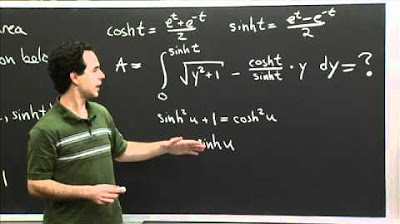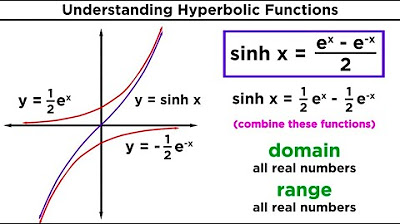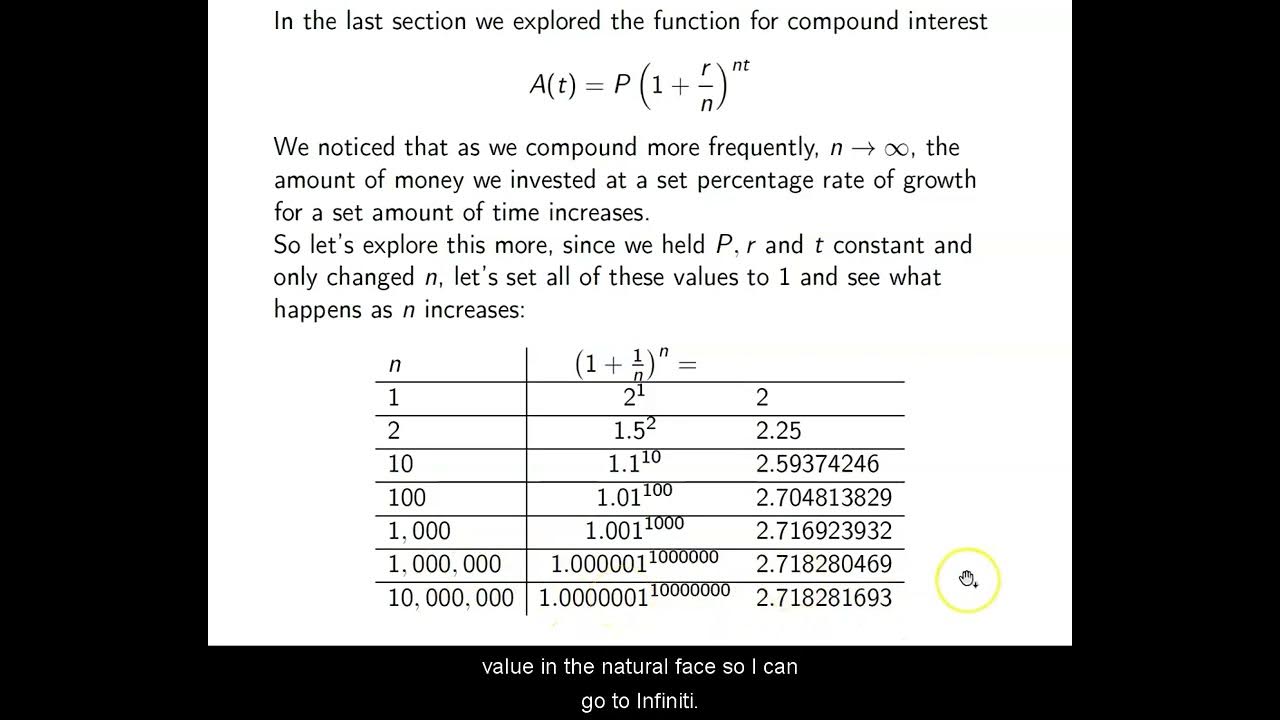Hyperbolic trig functions | MIT 18.01SC Single Variable Calculus, Fall 2010
TLDRIn this recitation, Joel Lewis introduces hyperbolic trigonometric functions, focusing on 'cosh' and 'sinh', which are defined using exponential functions. He explains their graphical representation, showing exponential growth for both large positive and negative values of x. Lewis also discusses their derivatives, revealing a direct relationship between 'cosh' and 'sinh', akin to that of sine and cosine in circular trigonometry. The script delves into the connection between these hyperbolic functions and the unit rectangular hyperbola, highlighting the similarity in their relationship to the hyperbola as sine and cosine have to the unit circle. An exercise is provided to explore the angle addition formulas for hyperbolic functions.
Takeaways
- 📚 The lecture introduces hyperbolic trigonometric functions, which are not covered in the lecture due to exam review.
- 📈 The hyperbolic cosine (cosh) and sine (sinh) functions are defined using exponential functions, with cosh(x) = (e^x + e^-x) / 2 and sinh(x) = (e^x - e^-x) / 2.
- 📊 The graph of cosh(x) resembles a parabola with exponential growth on both sides, reaching a minimum at x=0 with a value of 1.
- 📉 The graph of sinh(x) shows exponential growth as x approaches both positive and negative infinity, passing through the origin with a slope of 1.
- 🔍 The derivatives of cosh and sinh are easily computed, with the derivative of cosh being sinh and vice versa.
- 🔗 The behavior of hyperbolic functions is reminiscent of circular trigonometric functions, particularly in their derivatives.
- 🌐 The connection between hyperbolic functions and the unit circle is replaced by a relationship with the unit rectangular hyperbola, defined by x^2 - y^2 = 1.
- 🔍 By setting x = cosh(u) and y = sinh(u), the point (x, y) lies on the right half of the unit hyperbola, tracing out this curve as u varies over real numbers.
- 🔄 The hyperbolic functions satisfy an identity similar to the Pythagorean identity of circular trigonometric functions: cosh^2(x) - sinh^2(x) = 1.
- 📝 The script suggests an exercise for students to find the hyperbolic angle addition formulas for sinh(x + y) and cosh(x + y) in terms of sinh(x), cosh(x), sinh(y), and cosh(y).
- 📚 The hyperbolic trigonometric functions have many analogous relationships to the regular trigonometric functions, making them an interesting subject of study.
Q & A
What is the main topic discussed in the script?
-The main topic discussed in the script is hyperbolic trigonometric functions, including their definitions, graphs, properties, and the relationship between these functions and the unit hyperbola.
How are hyperbolic trig functions defined in terms of the exponential function?
-Hyperbolic trig functions are defined using the exponential function as follows: cosh(x) = (e^x + e^-x) / 2 and sinh(x) = (e^x - e^-x) / 2.
What is the significance of the notation 'cosh' and 'sinh' for hyperbolic trig functions?
-The notation 'cosh' stands for hyperbolic cosine and is pronounced as 'cosh', while 'sinh' stands for hyperbolic sine and is pronounced as 'sinch', reflecting their definitions involving the hyperbolic nature of the functions.
How do the graphs of cosh(x) and sinh(x) behave as x approaches positive or negative infinity?
-As x approaches positive infinity, cosh(x) approaches infinity, and sinh(x) also approaches infinity. As x approaches negative infinity, cosh(x) approaches infinity, while sinh(x) approaches negative infinity.
What is the minimum value of the hyperbolic cosine function, and at what point does it occur?
-The minimum value of the hyperbolic cosine function is 1, and it occurs at x = 0.
How are the derivatives of cosh(x) and sinh(x) related to each other?
-The derivative of cosh(x) is sinh(x), and the derivative of sinh(x) is cosh(x), which is similar to the relationship between the derivatives of sine and cosine in regular trigonometry but without the negative sign.
What is the unit hyperbola, and how does it relate to hyperbolic trig functions?
-The unit hyperbola is the set of points (x, y) that satisfy the equation x^2 - y^2 = 1. It relates to hyperbolic trig functions because if x = cosh(u) and y = sinh(u), then the point (x, y) lies on the right branch of the unit hyperbola.
Why do hyperbolic trig functions have the word 'trig' in their names?
-Hyperbolic trig functions have the word 'trig' in their names because they share a similar relationship with the unit hyperbola as regular trig functions have with the unit circle, including analogous properties and identities.
What is the equation that the point (cosh(u), sinh(u)) satisfies?
-The point (cosh(u), sinh(u)) satisfies the equation x^2 - y^2 = 1, which is the equation of the unit hyperbola.
What exercise is given to the students at the end of the script?
-The exercise given to the students is to find the expressions for sinh(x + y) and cosh(x + y) in terms of sinh(x), cosh(x), sinh(y), and cosh(y), which are the hyperbolic counterparts to the angle addition formulas in regular trigonometry.
What is the relationship between the hyperbolic trig functions and the unit circle?
-While hyperbolic trig functions are related to the unit hyperbola, they do not have a direct relationship with the unit circle like regular trig functions. The unit circle is associated with circular trig functions, where points on the circle can be represented as (cos(t), sin(t)).
Outlines
📚 Introduction to Hyperbolic Trigonometric Functions
In this segment, Joel Lewis introduces the concept of hyperbolic trigonometric functions, which were not covered in the lecture due to exam review. He begins by defining the two primary hyperbolic functions, the hyperbolic cosine (cosh) and the hyperbolic sine (sinh), using exponential functions. The definitions are cosh(x) as (e^x + e^-x) / 2 and sinh(x) as (e^x - e^-x) / 2. Lewis then describes the graphical representation of these functions, noting their exponential growth and shape, which resembles a parabola but with much steeper growth due to the exponential nature. He also touches on the minimum value of cosh(x) at x=0, which is 1, and the slope of sinh(x) at the origin, which is 1. The paragraph concludes with a mention of the derivatives of these functions, which are easily computed from their definitions, and how they relate to each other, similar to the relationship between the derivatives of sine and cosine in regular trigonometry.
🔍 Derivatives and Analogous Behavior of Hyperbolic Functions
This paragraph delves deeper into the properties of hyperbolic trigonometric functions, focusing on their derivatives and their behavior in comparison to regular trigonometric functions. Lewis explains that the derivative of cosh(x) is sinh(x), and vice versa, without the need for a negative sign, which is a notable difference from the relationship between the derivatives of sine and cosine. The paragraph also introduces the reason behind the 'trig' in hyperbolic trigonometric functions, drawing a connection between these functions and the unit rectangular hyperbola, as opposed to the unit circle associated with circular trigonometric functions. The unit hyperbola is defined by the equation x^2 - y^2 = 1, and Lewis demonstrates that setting x = cosh(u) and y = sinh(u) satisfies this equation, showing the relationship between hyperbolic functions and the right half of the hyperbola. The paragraph concludes with the observation that hyperbolic functions trace out the right half of the hyperbola as the variable 'u' varies over the real numbers.
📘 The Relationship Between Hyperbolic Functions and the Hyperbola
In the final paragraph, Lewis further explores the relationship between hyperbolic trigonometric functions and the hyperbola. He explains that just as the regular trigonometric functions are related to the unit circle, hyperbolic functions have a similar relationship with the unit hyperbola. By setting x = cosh(u) and y = sinh(u), it is shown that these points lie on the hyperbola defined by x^2 - y^2 = 1. The paragraph also discusses the limitations of this relationship to the right half of the hyperbola due to the nature of hyperbolic cosine always being positive. Lewis then contrasts this with the behavior of the left branch of the hyperbola, which could be traced by (-cosh(u), sinh(u)). The paragraph concludes with an exercise for the viewer to find the hyperbolic angle addition formulas, which are analogous to those of regular trigonometric functions, thus reinforcing the parallel between the two sets of functions.
Mindmap
Keywords
💡Hyperbolic Trig Functions
💡Cosh
💡Sinh
💡Exponential Function
💡Derivative
💡Unit Circle
💡Unit Hyperbola
💡Asymptote
💡Graph
💡Trigonometric Functions
💡Angle Addition Formulas
Highlights
Introduction to hyperbolic trigonometric functions, which are not as commonly taught as circular trigonometric functions but have unique properties and applications.
Definition of hyperbolic cosine (cosh) and hyperbolic sine (sinh) in terms of exponential functions, providing a foundation for understanding their behavior.
Explanation of the notation and pronunciation of cosh and sinh, emphasizing the 'h' for hyperbolic and the unique pronunciation of 'sinch'.
Graphical representation of cosh and sinh functions, illustrating their exponential growth and shape, which resembles a parabola but with much steeper curves.
Identification of the minimum value of the cosh function at x=0, highlighting its behavior as x approaches positive or negative infinity.
Derivation of the derivatives of cosh and sinh, showing that the derivative of cosh is sinh and vice versa, without the need for a negative sign.
Comparison of the derivative properties of hyperbolic functions to those of circular trigonometric functions, noting the absence of a negative sign in hyperbolic derivatives.
Introduction of the unit circle and its relationship with circular trigonometric functions, setting the stage for a deeper understanding of hyperbolic functions.
Transition to the unit rectangular hyperbola and its equation, which is fundamental to understanding the connection between hyperbolic trigonometric functions and this geometric shape.
Demonstration of how points on the hyperbola can be represented using cosh and sinh, with the equation x^2 - y^2 = 1, for the right half of the hyperbola.
Explanation of the relationship between cosh and sinh and the hyperbola, paralleling the relationship between cosine and sine with the unit circle.
Illustration of how the hyperbolic functions trace out the right half of the hyperbola, with cosh always being positive and sinh having both positive and negative values.
Introduction of the exercise to find the angle addition formulas for hyperbolic functions, encouraging students to apply their understanding of the relationship between hyperbolic and circular trigonometric functions.
Emphasis on the analogy between hyperbolic and circular trigonometric functions, suggesting that many trigonometric relationships have corresponding hyperbolic versions.
The unique growth rate of hyperbolic functions, which is faster than polynomial growth, is highlighted by comparing it to 1 + x^2.
The slope of the sinh function at the origin is shown to be 1, derived from taking the derivative and evaluating it at x=0.
The symmetry of the hyperbolic functions around the y-axis is discussed, noting the mirror image relationship for the left branch of the hyperbola.
Transcripts
Browse More Related Video

Hyperbolic Trig Sub | MIT 18.01SC Single Variable Calculus, Fall 2010

Hyperbolic Functions: Definitions, Identities, Derivatives, and Inverses

Lesson 3 - Hyperbolic Functions (Calculus 2 Tutor)

Why hyperbolic functions are actually really nice

Ch. 4.2 The Natural Exponential Function

Lesson 4 - Inverse Hyperbolic Functions (Calculus 2 Tutor)
5.0 / 5 (0 votes)
Thanks for rating: